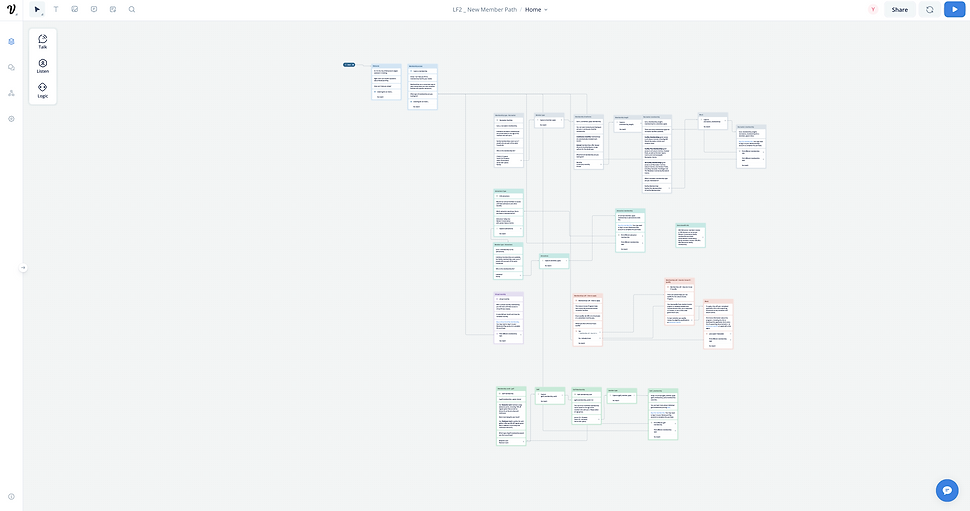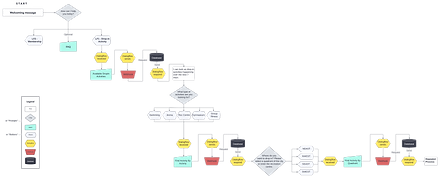A Digital Strategist, CX/UX Strategist

PROJECT TYPE:
Digital Assistant Development "Artificial Intelligence (AI) Application Development"
PROJECT DURATION: 12 Months
MY ROLE:
UX Strategist, Workshop Facilitator, Prototyping Logic Flows, Developing Training Material, QA
Project Context:
The YP team and I developed a digital assistant for the recreation parks and programs on the City of Edmonton's website, aiming to efficiently manage the high costs associated with city customer service staff.
CREDIT: Yellow Pencil Inc
Tools & Technology:
Dialogflow CX, Voiceflow, Lucidchart, Box, Wiki, Asana. Keynote.
Research and Planning
Project Description
The CRF digital assistant has been created in response to the high volume of emails the CRF Online Customer Service Unit receives from Edmontonians on a daily basis. Many of these emails involve simple procedural questions, currently managed at a high cost by City customer service staff.
Project goals
-
A web chatbot with a core series of FAQ intents and two complex logic flows built in Dialogflow CX.
-
Dialogflow CX integrated directly with Open Data, pulling dynamic data via webhooks where necessary in the flows.
-
A LiveChat integration that allows end-users to smoothly transition from their conversation with the digital assistant to live agent support.
-
An automated Dialogflow → BigQuery → Tableau data pipeline that allows the City to create a custom analytics dashboard in Tableau using data surfaced from digital agent interactions.
How did we evaluate the success of the digital assistant?
-
User testing to uncover issues that need addressing prior to launch.
-
Agree on and track KPIs or success metrics.
-
After launch, manual evaluation of the success of individual conversations was conducted and training was mapped out for areas that need improvement.
-
Asked users for feedback about the digital assistant.
Recommended Strategy
The CRF digital assistant was developed to deflect support tickets from live agents, guiding citizens to self-service channels for less complex inquiries and subsequently reducing time to resolution, boosting CSAT scores, and lowering cost per ticket. The digital assistant provides citizens with simple information about rec facility activities, programs, memberships, operating hours, and more.
When an inquiry is too complex for the bot to handle or a user needs to speak with a customer service rep to resolve their issue, the LiveChat integration kicks in.
Our Solution and Proposed Strategy
CRF Digital Assistant
In collaboration with the City, we identified two key flows to build out for the MVP launch:
-
Logic Flow 1 (LF1) helps users find available drop-in activities at the rec centre of their choice.
-
Logic Flow 2 (LF2) provides users with information about membership types and pricing.
Following Discovery sessions with the client and stakeholders, we recognized the critical role of Logic Flow 2 (LF2) in our project. To comprehensively address user interactions with the chatbot, we devised various scenarios for the logic flows using Voiceflow.
I developed the LF2 path tailored explicitly for creating a new membership. Afterward, I conducted detailed review sessions with the client and our internal team to ensure alignment with project objectives and client expectations.

Logic Flow's Strategies
Employing insights from our UX research, content analysis, and Recreation Centre database, we strategically designed and developed LF1 and LF2.
-
Logic Flow1 focused on assisting users of available drop-in activities at the chosen recreation center. Leveraging the recreation center database, we ensured the delivery of accurate information, offering details on specific activities at specific locations and times. This approach was crafted to align with user needs and optimize the functionality of the Logic Flow system.
-
The focus of Logic Flow 2 was on providing users with information about membership types and pricing. Although the membership information and types stayed constant, the pricing varied depending on the session or the number of family members. As a result, we developed a different strategy in designing LF2 to enhance flexibility for city employees, facilitating easier modifications. This strategic adjustment not only simplified updates for the city staff but also contributed to the Bot's responsiveness, ensuring a prompt and efficient user experience.
You can observe the differences in the diagrams provided below for each logic flow.
A full diagram of how LF 1 & 2 works in Dialogflow CX
I generated the diagram below specifically for client training. It visually represents how logic flows operate on Dialogflow and outlines the implementation of differences in these flows. The diagram places particular emphasis on illustrating the usage of Webhooks and the connection of the path to the database.

LF 1 on Dialogflow CX

Logic Flow 1 (LF1) helps users find available drop-in activities at the rec centre of their choice.
How does LF 1 work?
In Logic Flow 1, the webhook matches intents, based on the name of the intent, to call specific functions and generate fulfillment responses: • AvailableDropInActivitiesIntent
Fulfillment for this intent is generated by a function called getResponse. The response includes the suggestion chips for activity types, these are generated from the existing values in the activitygroup column in the mdkr-4c27.json dataset.

LF 2 on Dialogflow CX

Logic Flow 2 (LF2) provides users with information about membership types and pricing.
How does LF 2 work?
In Logic Flow 2, the webhook matches intents, based on the name of the intent, to call specific functions and generate fulfillment responses: • Memberships.RecreationCentres.Cost
Fulfillment for this intent is generated by a function called getRecreationCentresResponse.
The response includes a message text with pricing information. This data is queried from the t5ft-guz9.json dataset based on the membership-location, membership-length and membership-age-group parameters received from Dialogflow.

Digital Assistant Test Environment
Due to the comprehensive training of the Digital Assistant in handling various scenarios and complex logic flows it became critical to test the bot's diverse paths from multiple perspectives thoroughly.
As a UX Strategist, I tested all paths to ensure the absence of bugs or broken paths while verifying that each path worked accurately, delivering an optimal user experience. I specifically tested various scenarios identified as potential issues during the early discovery phase, ensuring comprehensive consideration and confirming their seamless functionality.

Traning Strategy
Traning Goals
To assist the CoE team in understanding how to support digital assistants in the future, we spoke with the client to understand their needs. The result was to arrange three training sessions covering the digital assistant's technical and general aspects and explaining its implementation for different target groups within the CoE team. I crafted and delivered three training materials for these sessions, which you can review for more details
Training Sessions
Session 1: An overview of the digital assistant and the rationale behind our approach in general.
Session 2: An overview of Dialogflow and our implementation of it.
• Ensure the CoE team understands Dialogflow at a high level.
• A walkthrough of how to create and manage intents so the CoE team knows how to do this themselves.
• Additional Dialogflow training to ensure the CoE team feels comfortable accessing, maintaining, and making minor changes to the chatbot.
Session 3: High-level overview of the software and components that make up the chatbot ecosystem.
• Technical training covering how each piece of software was implemented, how everything connects, why each software component was chosen, and what the function of each component is.

